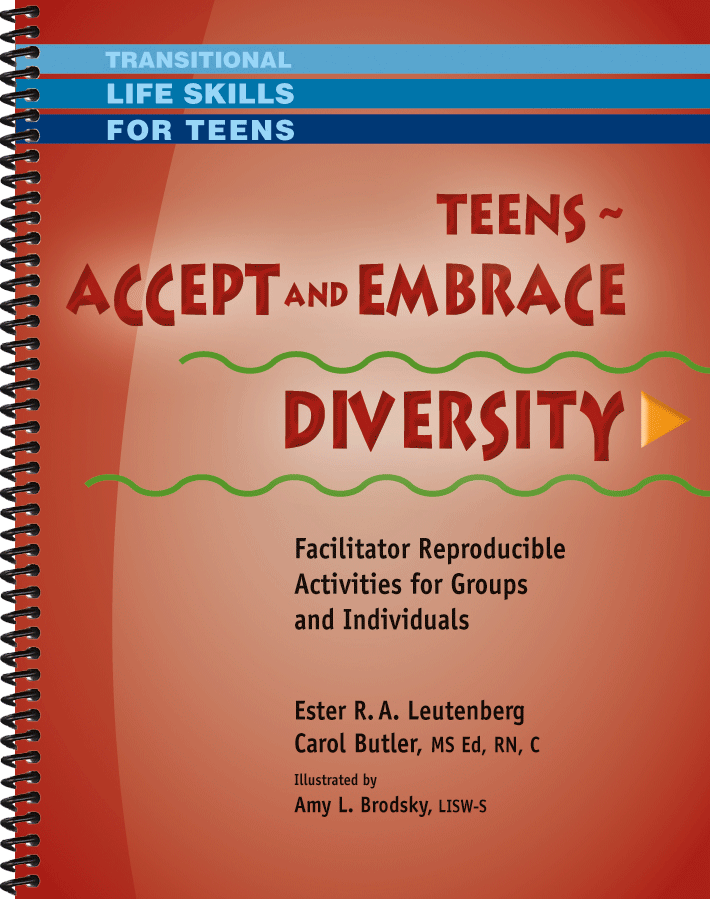Teens - Accept and Embrace Diversity
Facilitator Reproducible Activities for Groups and Individuals
Exclusion or inclusion, discord or harmony hinge on hating or appreciating cultural differences. This book is relevant today because school shootings and teen suicides often relate to being left out, laughed at, and bullied because of cultural differences.
Teens - Accept and Embrace Diversity capitalizes on what comes naturally – cohesion, not cruelty. To welcome diversity reduces prejudice and nurtures respect for one’s and others’ cultures. Teens can un-learn bigotry and become broad-minded, experience empathy for people they previously judged, and replace criticism with compassion. The activities in this workbook will encourage teens to accept the various cultural views of others and to become aware of the influences of their home life, environment, friends, community, and media. They will be encouraged to think for themselves.
Embracing diversity is a step toward a fuller expression of life and a better quality of life for marginalized people. It can also help perpetrators of prejudice to become promoters of peace.
The seven chapters include:
- Accepting Diversity
Diversity definitions and cheers, cultural considerations, assimilation and multiculturalism, chess game and animal analogies, commonalities and closed-minded versus open-minded reactions.
- Physical Diversity
Prejudice or preference based on appearance, sensitivity toward people with disabilities, disease conditions, or sensory impairments. Refute misleading media messages about a perfect body.
- Mental Diversity
Ways to diminish stigmas against people with mental health issues or learning difficulties, overcome cultural barriers to expressing feelings and seeking help, dispel myths about mental illness, and recognize everybody has strengths.
- Social Diversity
Hate and hope, socioeconomic status, gender stereotypes, being an ally – not a bystander, sexual orientation issues, motives underlying bullying and bigotry, and viewing people as multi-dimensional – learning not to pigeonhole them based on one trait.
- Exceptions to Acceptance
To reject media messages that glamorize aggression and to promote a culture of non-violence through song lyrics, posters, debates, bumper stickers, mock videos, panel discussions, etc.
- Avoiding Stereotypes and Prejudice
Self-segregation versus inclusion, non-judgmental attitudes, unlearning hate and learning to love, identifying dangers of labels, scapegoating, making false assumptions about fame and failure, facing mob mentality versus individualism, seeking people, places, and things that define one’s roots, defining reasons not to bully, and studying civil rights quotations and depictions.
- Advocacy in Action
The difference one person can make, the value of collaborative efforts at home, school, the community, and the world, the personal attributes of an advocate, and ways to use one’s talents to give back to the universe.
This workbook is also available in PDF eBook format, making it simple to store on your computer or mobile device and to access with a PDF viewer. The PDF format allows you to easily print copies of the activities and worksheets during therapy and counseling sessions.
 Teens – Accept and Embrace Diversity Card Deck
Teens – Accept and Embrace Diversity Card Deck
Use the open-ended questions with groups or individuals to kick-start a session. Each question corresponds to a specific page in the book.
Sample Questions:
In what ways do lyrics combined with dance better express emotions than words alone?
Ask the group: "What is a multifaceted gem?" (diamond and others) and "What does it mean when a person is multifaceted?" (many-sided, complex)
In one word, name one of your most positive traits? Go around the room and ask each person to answer the same question.


